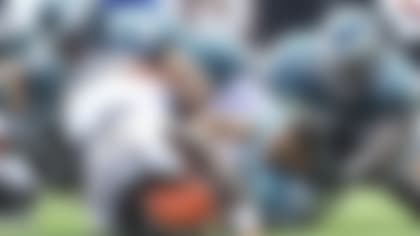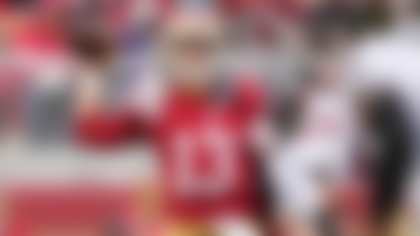In his robust Inside The NFL notebook below, NFL Network's Albert Breer touches on multiple topics including (click on the link to take you directly there):
» Four things he's looking forward to in Week 2.
» How Rex Ryan could impact Mike Wallace's contract talks.
» The ramification one Peyton Manning bridesmaid has already felt.
» And much more, beginning with how defenses are dealing with the NFL's offensive revolution ...
The 791 points scored over the past six days set a Week 1 record. An unprecedented five teams broke the 40-point barrier on Sunday and Monday. But that kind of scoring outburst didn't happen in every NFL city.
The San Francisco 49ers, a defensive juggernaut last season, held the explosive Packersto 14 offensive points. The Philadelphia Eagles, who aren't nearly in the Niners' class defensively, held the Brownsout of the end zone altogether. The Denver Broncoslooked good against a talented Pittsburgh Steelers group, the New York Jets looked revived and aggressive against Buffalo, and the New England Patriots and Dallas Cowboys showed signs of turning around defenses that have been liabilities.
So here's the question for those that did, in fact, play ball on both sides over the weekend: Is there any stopping an aerial trend that had three quarterbacks exceed 5,000 yards in 2011 -- a figure only crossed twice in NFL history before then? Or is just too hard now to expect as much as a defensive coach used to?
"The offenses have spread the field a lot more; you have more formation variations, empty-backfield sets, teams going three or four receivers every time and tight ends that are good receivers," 49ers defensive coordinator Vic Fangio said Monday night. "There's more audibling, you have the rule changes. It's a little bit of everything that's made it more offense-friendly than it was in the late 1980s through the late '90s. And so if you have a good quarterback, you can play good offense with average personnel around him. It's much harder now to play good defense with average personnel."
While there was widespread perception last season that offenses would be behind because of the lockout, the opposite proved true. As Mike Zimmerexplained it to us last fall, many coaches on the defensive side of the ball were trying to install everything, despite the time crunch, and the result was bewildered players, busted coverages and big plays all over the field.
Zimmer said that after talking to Bill Parcells and Chuck Fairbanks to prepare for 2011, "One thing they told me is that if you try to put everything in, you'll have a big mess and the players will be confused. So we went slow, putting in one coverage and one or two base pressures a day through camp." Cincinnati finished seventh in total defense and made the playoffs.
The Niners came in fourth during the lockout-affected year and were creative like Zimmer. Fangio explained that, in addition to Jim Harbaugh finding extra reps for everyone, he decided that his defense would not prepare for any of the preseason games, trying to steal extra practice time where his group might normally be readying itself to play a contest that didn't count.
The flipside was in Philadelphia, where new defensive coordinator Juan Castillo was transitioning after 13 years as an offensive line coach. The Eagles eventually ascended to eighth in total defense, but not before a messy start made worse by all the new faces (Nnamdi Asomugha, Dominique Rodgers-Cromartie, Cullen Jenkins) he was trying to fit into a new scheme. When asked about the difference between 2011 and the product unveiled in Cleveland, Castillo provided a simple response: "The OTAs," he said.
"We took one coverage and we'd go and we'd practice that one coverage. Say we had 50 plays in that practice, we ran the same coverage 50 times. OTAs, right? I mean, c'mon," Castillo said. "That makes a big difference. And sometimes, what we'd do with the main coverages is that we'd use it for two days. So against our offense, we'd run the same coverage. Say we had those 50 plays a day -- then for 100 plays, we ran that same coverage."
Yes, it was the Browns on Sunday. But Rodgers-Cromartie's two picks and Asomugha's aggressive play, plus the line's stonewalling of a strong Cleveland front, had plenty to do with the continued righting of the wrongs of early 2011.
The defense, Castillo explains, is more versatile now, and more ready to deal with whatever an offense throws at it. Last year at this time, the guys were trying to figure out where to line up.
"This week, we needed (the corners) to be by themselves, we needed help inside," Castillo said. "Next week, we may need the help down and the guys inside may need to be by themselves. It just depends. It's matchups. It's nice to be able to do what you need to, though, and say, 'OK, Dominique, Nnamdi, you guys are by yourselves because we have to take away the inside.' "
So theoretically, there should be a market correction in 2012, right? We certainly didn't see it on a widespread basis in Week 1.
And there also isn't anyone denying which way the tide is going.
"I think what you've seen will become the norm to a degree, but I'm not sure if you'll have everyone throwing for 5,000 yards," Fangio said. "If quarterbacks are capable, they'll have a lot on their plate, be able to run the offense from the line of scrimmage, and make it tough on us. And that's part of it. In the early 2000s, when the Ravens and Bucs won, there was a real lack of quality quarterbacks. That's been solved. Whoever you'd rank as the bottom 10 quarterbacks now, they're much better than the bottom 10 then."
Instant Debate: San Francisco treat

San Francisco logged a huge win over Green Bay. Were you more impressed by the 49ers or disappointed in the Pack? **More ...**
Fangio says the big key he's drilled into his players -- and this will sound boring -- is to be as fundamentally sound as humanly possible. Because it's already tough enough, and if you're not playing a tight game, it'll become that much tougher.
But there is another key here that's even simpler. It's also why, when asked if he's had to adjust his expectations, Fangio can afford to bristle at the notion.
"We haven't, no, we certainly haven't," said the coach of a fairly loaded group. "Sometimes, in certain weeks, those goals will be harder to achieve. But we haven't adjusted the expectations. Let's face it -- good players are always the answers. And that's the key. We try to get good players."
Four things to look for in Week 2
1) The RG3 adjustment.Redskins coaches held back a significant amount of their offense in preseason as they built around Robert Griffin III, things that were termed to me as "all the stuff he's good at." And clearly, they unloaded a double-barreled barrage of Baylor-style schemes at the Saints. Griffin looked fantastic, poised and prepared for the moment. But as one scout put it, "Ask me how he does in Week 8 when everyone has film of this offense." This week should provide an interesting test, with an aggressive, young defensive front and ballhawking secondary waiting in St. Louis. Still, there's no minimizing what Griffin did last Sunday, which was walk into a tiger's den and positively dominate. That's enough to make him must-see TV until further notice. But here's one more angle anyway: The Rams happen to be the team that traded, in essence, Griffin's rights -- which means, if this keeps up, Sam Bradford will be saddled with comparisons.
Jones: Opening statement
The Jets have been treated like a circus sideshow, but Kimberly Jones says nobody's laughing at them now. **More ...**
2) How the Jets deploy Revis in Pittsburgh. Probably the best game Sunday is between two teams that met with a Super Bowl berth on the line just 20 months ago. And while most of the attention will remain on how the suddenly prolific Jets offense handles Blitzburgh, a potentially dynamic group on the other sideline will slip under the headlines for a second straight week. Ben Roethlisberger acquitted himself well in Sunday night's loss to Denver -- playing in Todd Haley's offense for the first time -- as did his group of receivers. But who's his No. 1 guy? The truth might be revealed by Rex Ryan. Ryan put Darrelle Revis on Mike Wallace in a December 2010 game between these teams, and again in the AFC title game a month later. So does Ryan do it again this time? Or is Antonio Brown, he of the blockbuster five-year extension, bound for Revis Island? Interesting for us, of course. But more than that, it could become a discussion point in Wallace's negotiations after the season.
3) How many hits Vick takes. The 11 shots levied on Michael Vick in Cleveland served as a reminder of how big a loss Jason Peters is for Philly. Part of the reason for the beating might have been Vick's approach. He told me the hit he took against the Patriots in the preseason had this effect on him: "I sorta said to myself, 'You know what? Stop worrying about playing not to get hurt.' Two weeks in a row, against Pittsburgh and New England, my mindset was just to play cautiously and not get hurt and get through the preseason to the regular season. And I just told myself, 'I can't play like that.' I can't play with so many different things on my mind. ... If the good Lord don't want you out there, and you're gonna sprain an ankle or tweak your thumb, that's what's gonna happen. Go out there and play lights out. That's why we have backups." Interesting, because it's reversing field from what he said earlier in the offseason.
4) The handshake. Can't help myself on this one. The thought of Jim Harbaugh skipping giddily across the Ford Field turf last fall makes me crack. Both he and Jim Schwartz say they're beyond last year's moment, and that's fine. I wrote then that I liked the altercation. And I stand by that. I don't think there's any greater indication of a coach having a hold on his team than when the players inherit his traits. Both these clubs, sadsacks when the coaches arrived, have done that. So Harbaugh and Schwartz go a little overboard? So what? The emotion and intensity from both is genuine, and it's one of many reasons why Sunday night's result could resonate in the standings, like last year's Niners win did.
Three conclusions
1) Sean Payton's loss will be felt. And I'm not basing that on what happened last Sunday. This is more about a fact well known within league circles: On gameday, Payton gave New Orleans the advantage almost every week. It's a good bet the 2012 Saints are fine Monday through Saturday. I have evidence it's tougher on Sunday. Last year, when Payton tore his meniscus and broke his tibia, he spent four games in the box. The Saints were 2-2 in those games. They were 11-1 with him on the sideline. Drew Brees told me the day Payton returned to the sideline that "just his presence (was huge). He's our head coach and we all look up to him a great deal. And certainly through the course of the game, the ebb and flow, he's got his hand in everything. He's coaching everybody, and you see things on the field you don't see up in the box. I think he missed that fire, that part of it. It was great having him down there." Now, think about that. Brees is simply citing the difference between having Payton on the sideline vs. the box. Makes it hard to believe his absence isn't felt.
2) The Peyton chase had ramifications. If there was any silver lining coming for the three primary bridesmaids in the Peyton chase last Sunday, it had to be that, at least, they now know they were right to pursue him. By the early looks of it, Jim Harbaugh's Niners are no worse for the wear from their "evaluation" of Manning. Different story in Arizona and Tennessee. The Cardinals' quarterbacking woes, on an otherwise very solid team, are well documented. The Titans' resulting issues are harder to find, but do exist. The Titans were pursuing free agent center Scott Wells during the Peyton chase and, had they not needed to save the money for Manning, believe they would've landed the former Tennessee Vol. Instead, Wells landed in St. Louis (to be fair, he is now hurt) and the Titans went, more or less, with what they had up front. And so it's no surprise that the Patriots dominated Tennessee at the line Sunday. Again, worth the risk to roll the dice on Manning. But Wells would've been a nice consolation prize.
3) The Texans had no choice but to sign Matt Schaub long term. And it was wise to get it done now. Yes, $15.5 million per year is a steep price, outpacing Eli Manning and Philip Rivers, and falling just short of the man Schaub used to back up in Atlanta, Michael Vick. But internally, if the experience of having Matt Leinart go down instantly (there were some there who thought he was better in camp than Schaub in 2010) and trying to get by with T.J. Yates taught the team anything, it was to appreciate what they had in No. 8. Schaub and running mate Andre Johnson were very open with me last month about the team entering its window of championship opportunity. Having stability at quarterback serves as the foundation, and the deal covers the rest of Schaub's prime. "Boy, that's a lot," said a rival team executive, when apprised of the financials. "But no one knows more about the guy, and you have to think they see this as their window with him, the next four years, because you'd think that's the window with Johnson and (Arian) Foster."
Two college players to watch this Saturday
1) Tennessee QB Tyler Bray (vs. Florida, 6 p.m. ET, ESPN). The 6-foot-6 junior has everything you'd want in a quarterback -- except for big wins against top teams. The Vols haven't beaten Florida in eight years, so this would qualify as one. "He's got NFL traits, size and arm strength," an AFC college scout said. "Functional athlete, but more of a pocket passer, good arm. He's been in the news some for 'living the college life' a little too hard, but he's talented." The scout went on to say he needs to prove "he can beat an SEC team that isn't named Vandy, Kentucky or Ole Miss." At this point, Bray is considered a notch below guys like USC's Matt Barkley, Arkansas' Tyler Wilson and Oklahoma's Landry Jones on a list of college football's top quarterbacks.
2) Michigan State RB Le'Veon Bell (vs. Notre Dame, 8 p.m. ET, ABC). Bell's grinding, 210-yard effort against Boise State made him a Heisman sleeper. Saturday night will provide another big stage for the 6-foot-2, 244-pound jackhammer. One college scouting director said that Bell's one weakness is "top-end speed," but that he's a "good back -- an all-around type, excellent size. He does everything well, he catches the ball, he's a good power runner." Making this one even a little more intriguing is that Bell figures to be head-to-head against another old-school mudder-type, Notre Dame linebacker Manti Te'o, under the lights in East Lansing.
One prediction
The questions with Brandon Weeden won't subside for a while. It was clear Sunday, and will be going forward, that the Browns are going to endure. One talent evaluator referred to the learning curve Weeden faces going from Oklahoma State's spread to the West Coast offense as "enormous."
It's clear his pocket presence and feet need to improve, as does his awareness of things around him.
What separates Andrew Luck and Griffin from Weeden and Ryan Tannehill, at this point at least, is that the former were more polished entering the NFL and have had systems built around them, while the latter came in raw and have to adjust. For Weeden, the issue is exacerbated by his age, which will effect perception after the season. And then, there's the possibility new owner Jimmy Haslam wants to clean house.
Either way, if Weeden does continue to struggle, Cleveland could be going into 2013 with new decision makers in place and a decision to make on a quarterback nearing his 30th birthday. All of which sure does explain why Weeden, who has tools and is a good worker and locker-room presence, had to battle questions on his age in February and March, and why those questions were indeed valid.
Follow Albert Breer on Twitter @AlbertBreer




